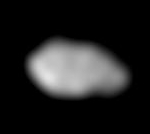Metis (moon)
Metis or Jupiter XVI, is Jupiter's closest moon.
 Image of Metis was taken by Galileo's solid state imaging system between November 1996 and June 1997. | |
| Discovery | |
|---|---|
| Discovered by | S. Synnott |
| Discovery date | March 4, 1979 |
| Orbital characteristics | |
| Periapsis | 127,974 km |
| Apoapsis | 128,026 km |
Mean orbit radius | 128,000 km (1.792 RJ) |
| Eccentricity | 0.0002 |
| 0.294780 d (7 h 4.5 min) | |
Average orbital speed | 31.501 km/s |
| Inclination | 0.06° (to Jupiter's equator) |
| Satellite of | Jupiter |
| Physical characteristics | |
Mean radius | 21.5 ± 2.0 km |
| Volume | ~42,700 km³ |
| Mass | 3.6 ×1016 kg |
Mean density | 0.86 g/cm³ (assumed) |
| 0.005 m/s² (0.0005 g) | |
| 0.012 km/s | |
| synchronous | |
| zero | |
| Albedo | 0.061 ± 0.003 |
| Temperature | ~123 K |
Metis was found in 1979 by Stephen P. Synnott in images taken by the Voyager 1 probe. Its designation was S/1979 J 3. In 1983 it was named after the mythological Metis, a Titaness who was the first wife of Zeus (the Greek equivalent of Jupiter).
Metis is not a sphere and measures 60×40×34 km across. The composition and mass of Metis are not known, but assuming that its mean density is like that of Amalthea (~0.86 g/cm³), its mass can be estimated as ~7×1016 kg. Amalthea's density implies that moon is composed of water ice with a porosity of 10-15%, and Adrastea may be similar.
The surface of Metis is very cratered. It is dark and appears to be reddish in color.
Orbit
changeMetis is the closest moon to Jupiter. It orbits Jupiter at a distance of ~128,000 km. It has a very small orbital eccentricity (~0.0002) and inclination (~ 0.06°) relative to the equator of Jupiter.7
Exploration
changeThe images taken by Voyager 1 showed Metis only as a dot, and very little was known about Metis until the arrival of the Galileo spacecraft. Galileo took pictures of almost all of the surface of Metis and put constraints on its composition.
Other websites
change- Metis Profile Archived 2007-11-09 at the Wayback Machine by NASA's Solar System Exploration